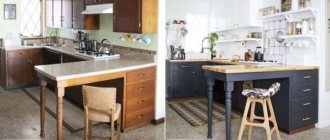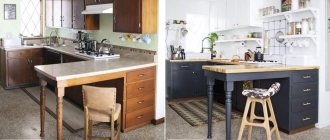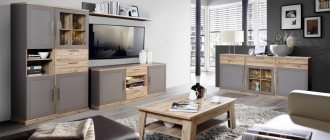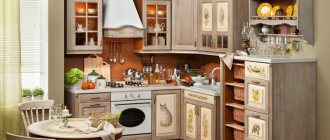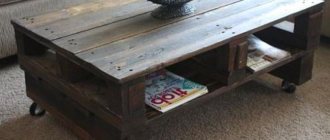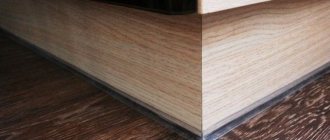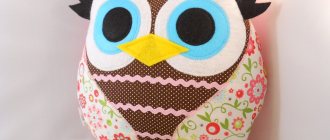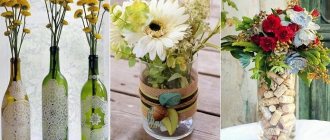The kitchen set is subjected to heavy loads, so sooner or later the time comes when it loses its attractiveness. But this does not mean that strong cabinets that will last for many years will have to be thrown away and replaced with new ones. There is another way out: restoring kitchen furniture will help restore them to a decent appearance and save money. Let's consider methods of such repairs available at home.
Restoration of kitchen facades: different types
Facades are part of the kitchen that is constantly in sight. They primarily suffer during operation and lose their original beauty. Each type of facade has its own service life, its own characteristics of restoration and repair.
- Laminated. The base is MDF or chipboard, on which a melamine film is laid. They are inexpensive, but the coating wears out quickly. It is impossible to laminate the surface again at home, so depending on the nature of the damage, another renovation method is selected.
- Frame. The perimeter of the facade consists of MDF, and glass, plastic, chipboard or rattan is placed in the center. Not resistant to damage, but easier to repair.
- Coated with plastic or PVC. These materials make the furniture attractive and resistant to damage at an economical price. It is not difficult to restore such facades: the most common problem is the peeling of the protective layer from the base, which is solved with the help of glue.
- Wooden facades. Elite furniture consists entirely of solid wood, which is incredibly expensive. Therefore, more often only the façade parts are made of wood. For this, species such as beech, teak, oak, walnut, and maple are used. Such headsets are practically eternal with proper care; minor damage can be repaired yourself.
Attention! A selection of photos of the sets before and after restoration is presented at the end of the article.
Varnishing
Repairing a kitchen set made of wood comes down to restoration, especially if the material is quite expensive wood. And old wooden furniture, both today and centuries ago, is perceived as a symbol of solidity. Moreover, wooden kitchen units are not that difficult to update.
The most popular techniques are varnishing and tinting; they are often combined. The varnish can be used as matte transparent, glossy or even colored. It doesn’t radically change the color palette of the furniture, but it does add some shade. Stain is used in cases where they really want to change the color of the facade by a couple of tones.
The technology of both processes is similar.
- The facades are removed from their hinges and the fittings are removed.
- The surface is cleaned of old varnish or other finishing, treated with sandpaper, coarse and fine, and then thoroughly sanded.
- The cleaned surface is primed.
- After the primer has completely dried, a layer of varnish is applied to the facade with a brush. After the varnish has dried, the procedure is repeated at least twice.
The stain is applied in the same way, after the soil has dried. Depending on how much they want to change the color of the furniture, tinting is carried out from 1 to 4 times. Then the product is opened with varnish at least twice.
Molding – furniture plinth of different shapes – will help diversify the look of updated furniture. It is very diverse in size and configuration. The molding is glued to the surface of the facade and can be painted and varnished along with the sash.
DIY kitchen renovation ideas
How to breathe new life into old kitchen furniture? There are quite a few ways:
- Decorating with stickers will help hide minor scratches and chips.
- Covering with film will hide more serious damage.
- Painting gives a completely different look to the facades of kitchen units.
- Applying varnish is usually used to restore and protect furniture made from natural wood.
- Decoupage is the application of appliqués or raised patterns.
- The use of moldings and decorative overlays made of wood or plastic.
Decorative stickers
Facades covered with film
Kitchen updated with varnish
Painted MDF facades
Decoupage
Decorative furniture overlays
To achieve a better result, these methods are combined. Let's take a closer look at restoration methods and features of restoration of different types of facades.
How to decorate a kitchen set
Those who have a question about how to transform the facade of a kitchen unit with their own hands should know that there are many ideas and techniques in this regard. The main thing is to choose the right decorations that will look harmonious with the overall design of the room. For decoration, all kinds of stickers, paint, varnish and even additional elements can be used.
Hand-made things are in particular demand because they reflect the inner world of the owner, her talent and skills.
If you want to give a monotonous kitchen new colors, brightness and life, it will be enough to update the color of the kitchen set. With the modern choice of building materials, this will not be difficult to do. Remodeling with rattan inserts will give the façade new life. The main thing is to make the correct measurements first.
Rattan is often found in the interior of our apartments.
If the outer sides of the cabinets do not have obvious and visible damage, then painting can be used; the use of antique techniques is popular. To do this, you just need to go over the painted canvas with a special sanding material; it slightly scratches the paint layer, giving the surface an aged appearance.
The aging effect manifests itself when dark areas peek through light paint, and vice versa.
Another interesting option is ceramic tiles. You can also use mosaic elements.
When choosing tiles for the kitchen, take a closer look at its texture.
Ceramic tiles
Another option for decorating an old kitchen surface is ceramic tiles. You should choose the material carefully; it is better to give preference to small-sized parts. Advice from a professional in the store will help you purchase the most suitable ceramic tiles for a particular type of finish.
Uneven contours, imitation of aged clay tiles or stone are suitable for a set in country and Provence style.
Fastening tiles is an important process; if you do not have experience in such construction work, then it is better to contact a specialist who will do the work and provide certain guarantees.
Large and medium-sized elements are not suitable for a miniature kitchen. Such decoration will only increase the feeling of crampedness in the room.
Rattan inserts
Recently, rattan inserts have become very popular. With the help of this technique, the covering of the facades will acquire newness, the transformation will benefit the kitchen furniture. Before you start cladding, you need to take the most accurate measurements from the surface on which the canvas will be applied, and then cut out the parts. The rattan fabric is attached using a construction stapler.
The range of wicker rattan furniture is varied.
Rattan is a material that you can play with and come up with different options for filling the surface with it. You can decorate the entire door, or part of it. If the fastening was not done carefully enough and the staples are visible, then decorative strips can be used, they will help hide the defects. Before attaching the canvas, it must be soaked in water.
Rattan decorative elements are ideal for any interior style.
Restoration of kitchen facades from MDF
Small chips and scratches are repaired with a furniture wax pencil. It is applied to the damaged area, and after hardening, the restored surface is sanded with fine sandpaper. The pencil is selected to match the color of the facade.
USEFUL INFORMATION: How to clean the ventilation in an apartment yourself
Decorative stickers will update the look of the headset and hide minor defects. Before gluing them, the surface is cleaned and degreased.
In case of more serious damage, it is necessary to completely change the appearance of the furniture. For kitchen facades made of MDF, painting or covering with vinyl film is suitable.
Using self-adhesive film
A quick and cheap method to radically change the look of your headset. The range of films is huge, so you can realize any design ideas.
Tip: choose quality materials. They will cost more, but a thick or textured film will lie smoother, and small scratches under it do not need to be repaired: they will be invisible.
Work algorithm:
- We unscrew the fittings from the facades, clean and degrease the surface for better adhesion.
- On the back side of the film there is a mesh with a cell size of 1 cm. Using it, we transfer the shape and dimensions of the surface to be pasted onto the material. It is recommended to leave allowances of 1–2 cm around the entire perimeter.
- Using sharp scissors, carefully cut out the measured fragment.
- We paste the film from top to bottom, gradually removing the protective coating and smoothing it with a plastic spatula or cloth from the center to the edges.
Important! Try to avoid the formation of air bubbles under the film. If they do appear, there are two ways to remove them. The first is to carefully peel off the film before the glue sets and re-stick it. The second is to pierce the bubbles with a needle and then smooth them out with a spatula.
When applying the sticker, pay special attention to the edges: in these places, most often the film begins to lift and peel off.
Coloring
It is important to remember that paint is applied only to areas that do not have external defects. Therefore, small scratches and chips are sealed in advance with wax or putty.
Acrylic paint or auto enamel is used in the work: it is more expensive, but more durable. Car spray is easier to apply, lays down more evenly, and better protects it from moisture and temperature in the kitchen.
Painting stages:
- We remove the doors and unscrew the fittings. Fixed elements that need to be protected from painting are sealed with masking tape.
- If the MDF surface is covered with film, remove it. A hair dryer will make the job easier.
- We process it with fine sandpaper, remove dust and degrease.
- Apply primer in two layers. For hard-to-reach places we use a brush, for smooth surfaces we use a roller. You can apply the primer using a spray gun. Be sure to let the first coat dry completely before applying the second.
- Apply the paint with a brush or roller in one direction. The aerosol is applied only with the use of a respirator. Surrounding objects also need to be protected.
- After the paint has dried, cover the façade with a layer of transparent varnish.
Coating restoration
Restoration of kitchen facades depends on both the base material and the finishing layer. In most cases, if the main material is damaged, the entire façade will have to be replaced. The exception is small scratches and chips, which can be repaired with a special wood putty or wax pencil.
When the finish is damaged, everything is not so clear.
- PVC film. The material does not adhere very well to chipboard or MDF due to its different nature. Over time, as well as under the influence of moisture and temperature changes, the film peels off. The advantage of the material is that restoration of such a coating is quite possible.
For small defects, the PVC film is simply glued: draw PVA glue, “Moment”, into a syringe from a needle and fill the area under the film. Then smooth out the coating and secure with tape for 4 hours. If the damage is extensive, you can remove the entire old film from the facade by heating it with a hairdryer, and stick a new one in the same way. In this case, it is better to use liquid nails.
- Melamine and acrylic films have much better adhesion to wood material, so they rarely peel off. Small areas are glued in the same way, but if the damage is extensive, the façade cannot be repaired at home: the coating will have to be changed in a workshop.
- Acrylic panel. This type of kitchen renovation is impossible. In case of severe chips or scratches, the sash must be replaced with a new one.
- The veneer is glued as easily as PVC film. Replacing it is also not difficult: the material is produced with glue already applied to the back side.
- Enamel. Repairing kitchen facades with your own hands is quite possible, although the work requires extreme care. Firstly, you need to clean out scratches or peelings, secondly, choose exactly the same shade, thirdly, apply it very carefully. If there is a large area of damage, it is better to entrust the work to a professional.
Restoration of the ends of chipboard furniture
The front surface of sets made of this material is restored using the methods described above. Other damage typical of furniture of this type, such as chips at the ends, can be repaired using melamine edges.
- In the store we select a new edge according to color and thickness. We measure the length of the required segment in advance and buy material with a small margin.
- We remove the old edging. To do this, heat the end with an iron.
- Using a chisel we remove the unevenness of the end, and then sand it with fine sandpaper.
- We put the new edge in place and smooth it with an iron. After the glue has hardened, we trim off the excess with a sharp knife and sand the joints.
USEFUL INFORMATION: Penalty for connecting a gas stove yourself
Replacement of facades
The simplest option, but also the most expensive, is replacing old kitchen facades with new ones. Agree that the price of the facades themselves is much cheaper than the price of a complete kitchen set, and the result will be as if you had completely replaced the kitchen.
The market for kitchen facades is saturated with products from various factories; you can always choose ready-made ones or order facades that suit you.
The procedure for replacing facades with your own hands:
- remove the old doors by unscrewing the screws from the hinges;
- remove the fronts from the drawers, carefully unscrewing the screws;
- fix new facades in place of old ones.
Advice. If you bought untreated facades, then they must be processed before hanging them in place. Prime them thoroughly, sand them after drying, and then paint them with varnish or paint at least 2 times. Process both sides. And only after that you can start hanging them in place.
Restoration of kitchen facades made of natural wood
Solid wood furniture looks great, but requires compliance with several operating conditions:
- The surfaces of wooden furniture should be cleaned with soft cloths soaked in a soapy solution. Do not use solvents or abrasive cleaners.
- Do not place hot dishes on the countertop.
- The humidity in the room should not rise above 70%.
- Minor damage and scratches must be repaired as soon as possible.
Scratches and cracks on the facades of solid wood furniture are repaired with melted wax. Chips are smoothed out with wood putty. After leveling the surface, the restored area is covered with a layer of furniture varnish.
If you need not just minor repairs, but a complete update of the appearance of the facade, replace the entire varnish coating. This is done this way:
- We dismantle the facades and remove the fittings.
- The surface is carefully treated with fine sandpaper. It is necessary to completely remove the old varnish coating. This is not always easy, especially if there are raised patterns or indentations.
- We remove varnish shavings and sawdust with a damp sponge or napkin.
- After drying, prime the surface twice, allowing each layer to dry before applying the next.
- Apply varnish with a brush or roller. We form the protective film in several layers, with each subsequent layer being thinner than the previous one. The varnish dries for at least a day in a well-ventilated area.
A different shade of wooden furniture will be given by stain or varnish with pigments.
You can change the set beyond recognition and give it a more modern look, as in the photo, by painting it.
Upgrade with PVC film
Restoration does not always mean only returning facades to their original appearance and replacing fittings. Modern methods of decoration make it possible to change the appearance of a kitchen beyond recognition, using quite affordable means.
One of these options is vinyl film, or rather, a sticker with an image on PVC film. Moreover, the image can be anything - from a wood pattern to an ornament of any complexity or a landscape.
Quite often, this technique is used to change the style of the kitchen or simply diversify the design. To do this, decorate an area or two doors with a sticker. If they want to update their entire set, all facades are covered with vinyl film. The choice is entirely determined by the style of the room.
Paneled facades are very suitable for such kitchen renovations. The frames are painted or also covered with a film of a different color, and the inner surface is decorated with self-adhesive film.
The photo shows a successful solution in the Art Nouveau style.
Moldings, overlays and decoupage
These restoration methods will give the kitchen set unique features: there is no limit to the scope for imagination.
Before applying jewelry, the surface for it is prepared: the application area is sanded, cleaned and degreased.
A 3D decoupage pattern is formed using a stencil: a material is applied through it to form a bas-relief. A popular option is to use wood putty. After drying, the pattern is sanded with sandpaper and covered with a protective layer of transparent or colored varnish.
Volumetric decoupage
Applying putty through a stencil
Decoupage with putty
For decoupage using napkins or decoupage cards, PVA glue is applied to the selected material. Then the drawing is applied to the cabinet door and smoothed out. After drying, apply 4 layers of matte or glossy varnish.
USEFUL INFORMATION: What color to paint the walls in the kitchen
Moldings are overhead wooden or plastic elements. They, like decorative overlays, are attached with glue to a previously prepared surface. For wooden moldings it is possible to attach them to small nails without heads.
Moldings and overlays
Updating your kitchen with moldings
Moldings for furniture
Furniture decor
Preparation for restoration
Kitchen restoration begins with preparatory work. Shelves and drawers are removed from cabinets and repaired as needed. It happens like this:
- It is necessary to check fasteners and connections for strength.
- Broken and rusty hinges should be replaced with new ones.
- Nails that do not sit securely in the socket must be pulled out, and the holes after them must be sealed with putty.
- Nail parts in other places with new nails.
- Secure the installed screws and new nails with wood glue.
After restoring the strength of the frame, it is necessary to remove decorative elements and fittings from the furniture. Before starting restoration, you should wash all surfaces of the cabinets and allow them to dry. After such treatment, all damage will be clearly visible, and a second series of preparation can be carried out.
The preparatory stage also includes removing the old coating, if necessary. The presented work is performed in the following sequence:
- Use sandpaper to remove the old layer of paint or varnish.
- Remove dust from the surface with a vacuum cleaner and apply a primer to it.
- Wax all scratches, if any.
- Mask all cracks on the surface with putty.
- Treat uneven areas caused by wax and putty with fine sandpaper.
Sometimes parasites appear in the kitchen - this is often noticeable by the grooves eaten by bugs. Before applying putty, they need to be soaked with an antiseptic. It would be a good idea to treat all surfaces with special compounds that protect against insects.
The preparatory stage is over, now the restoration of the old kitchen itself begins. There are many ways to update; you should choose the option that you can implement independently, both physically and financially.
Restoring countertops and kitchen tables: interesting ideas
To refresh a countertop or table surface made of chipboard, staining, decoupage and varnishing are used. But there are other ways, such as tiling, as in the photo below.
A countertop surface improved with ceramic tiles receives many advantages:
- Not afraid of water.
- Becomes more resistant to mechanical damage.
- Easy to clean and remove dirt.
The disadvantage of this modernization is a significant increase in the weight of the countertop. But since kitchen furniture is used permanently, there is no big problem here.
The tiles are laid using regular tile adhesive. But the work has its own characteristics:
- First, we attach metal corners to liquid nails along the perimeter of the tabletop. They serve as edging for the tiles and cover the end of the covering.
- We lay the tiles: tightly and with minimal gaps. The glue dries quickly, so you shouldn’t cover the entire tabletop with it at once. It is recommended to apply it in small portions under one or two tiles.
- We wait at least 6 hours until the glue dries completely, rub the seams and cover with a protective layer of varnish.
Another original way to transform a tabletop is to create a mosaic or ornament under tempered glass. Several slats or corners are screwed to the surface, which will divide the tabletop into zones. Decorative filler is poured into these sectors: small pebbles, coins, shells, beads or sand. From above, all this splendor is covered with impact-resistant glass, which is glued on.
Summary
As you can see, restoring kitchen furniture is not such a difficult task. The main thing is to have the desire to work with your own hands, embodying original solutions and fantasies.
Gallery
Did you like the article? Subscribe to our Yandex.Zen channel
Great article 0
Restoration of a burnt tabletop
Burnt countertops can be restored to their original appearance in the following way:
- Using a router, carefully select the damaged area. It is necessary to go deeper into the surface with ledges, reducing the area and slightly capturing intact material around the perimeter. The result is a recess that looks like a miniature quarry.
- Fill the hole with softened wood putty. It dries quickly, so we compact it into the recess in small portions.
- We cut off the protruding excess with a sharp knife, carefully sand the patch, and then polish it.
- We paint the restored area. In this case, you need to try to reproduce the color and texture of the main part of the countertop.
By combining these methods, you can restore kitchen furniture without large financial investments. This will not only restore the appearance of the old kitchen set, but also make it unique.
And finally, the promised selection of photos of kitchens before and after restoration.
Successful examples of restored furniture
The chair acquired a completely new appearance, it became more beautiful than the one made by the manufacturer. Its surfaces are smooth and bear a pattern. An excellent option for a kitchen in a classic style.
An example of kitchen restoration work.
As you can see, you can restore old furniture with your own hands, and it turns out quite well.
